|
NOTES AND
EXTRACTS
ON THE HISTORY OF THE
LONDON & BIRMINGHAM RAILWAY
CHAPTER 7
CONSTRUCTION ―
CAMDEN TOWN TO CHEDDINGTON
INTRODUCTION
“It is not
a little curious to turn back, and watch the first
beginnings of a work of such magnitude as this railway,
which will cost more than £5,000,000. In November, 1830,
there was to be one line of rails only, and the work was
to be done for £6,000 per mile. The capital was then one
million and a quarter, and no greater velocity
contemplated than eight miles an hour. Shares got up to
nine and ten premium on the prospectus, at which many
hundreds were sold. Then it was determined to have two
lines; and at that announcement the shares fell directly
to a discount . . . . We wonder that the speculators of
those days would have thought, if they could then have
been informed what the real cost of the present two
lines would be. One thing is certain, there would not
have been a railway between London and Birmingham for
many a year.”
The History of the
Railway Connecting London and Birmingham, Peter
Lecount (1839).
|
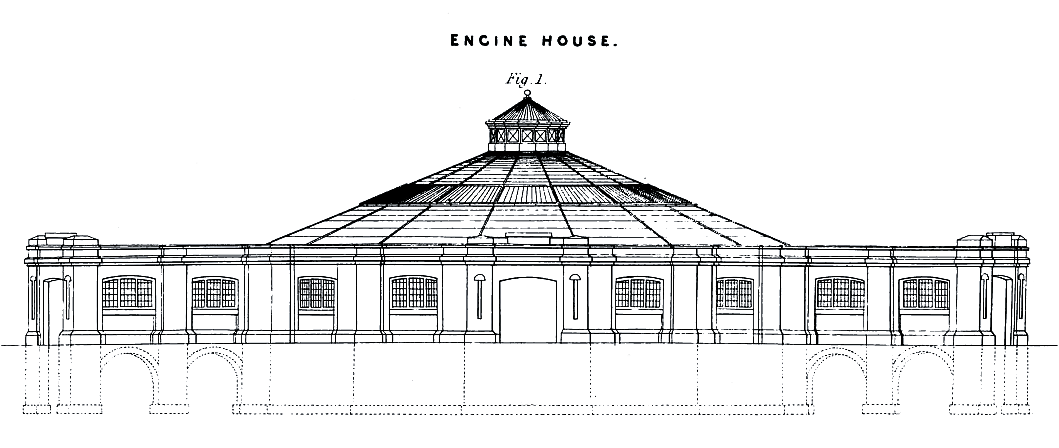
|
Originally planned for completion in September 1837 within a budget
of £2.5M, the London and Birmingham Railway was at the time and in every
sense the largest civil engineering project yet undertaken in the
United Kingdom:
“Up to that time no railway of similar
magnitude had been attempted. The line from Liverpool to Manchester
was by comparison a trifling work. Its length was little more than a
quarter of the length of the new road, and its most important works,
including the Sankey viaduct (with nine arches each of fifty feet
span thrown over the Sankey valley, and running seventy feet above
the Sankey canal), its principal tunnel, 2,250 yards long, and its
firm highway over the bogs of Parr Moss and Chat Moss, are in
respect of magnitude not to be compared with the Kilsby tunnel, the
Blisworth cutting, and the Wolverton embankment and viaduct. A man
of iron nerve would have experienced some uneasiness at the
commencement of such an undertaking.”
The Life of Robert Stephenson,
John Cordy Jeaffreson (1866).
Jeaffreson might have included in his
list of Stephenson’s more daunting challenges the Primrose Hill and
Watford tunnels, and the Tring Cutting, although a great deal of
heavy engineering was needed elsewhere to overcome Nature’s
obstacles while maintaining the line’s 1:330 (16 feet to the mile) ruling gradient.
It might
assist those unfamiliar with the terrain to list the main geographical
features
that required civil engineering solutions
in the form of embankments, cuttings, viaducts, bridges and tunnels.
In their guide to the London and Birmingham Railway, Roscoe and Lecount describe the
landscape thus:
|
“The country between London and Birmingham
is a series of basins or low districts, separated from each other by
considerable ridges of hills; the object to be gained was,
therefore, to cross the valleys at as high a point as possible, and
the hills at as low a one . . . . The whole will, therefore, stand
thus:―
1. The basin at London formed by the Thames.
2. The summit at Oxhey, near the division of the counties of
Middlesex and Hertford.
3. The basin of the Colne river. [Watford]
4. The summit at Tring.
5. The basin of the Ouse, near Stoney Stratford.
[Wolverton]
6. The summit at Blisworth, opposite Towcester.
7. The basin formed at Weedon by the streams flowing into the River
Nene at Northampton.
8. The summit at Kilsby, opposite Daventry.
9. The basin of the River Avon, crossed near Wolston, about five
miles south of Coventry.
10. The summit of the Meriden ridge.
11. The basin at Birmingham formed by the river Rea, which flows
into the Tame. . . .
. . . . Although there were found during the progress of this great
work numerous and severe difficulties, there was nothing to indicate
anything like what was experienced, and without expending vast sums
in boring, they could never have been anticipated.”
The London and Birmingham Railway, Roscoe and
Lecount (1839). |
The London and Birmingham was planned to open at the same time as the Grand
Junction Railway (sketch map), the two lines sharing a
terminus at Curzon Street. But
great difficulty in overcoming the large bed of quicksand found at
the southern end of the Kilsby Tunnel in
Northamptonshire delayed completion of the London and Birmingham
line, and it was over 12 months after the Grand Junction Railway had
arrived in Birmingham (the GJR opened for business on 4th July 1837)
before a through service between London and the North-West was
established.
Construction of the London and Birmingham Railway commenced at both ends:
“LONDON AND BIRMINGHAM
RAILWAY ― The average number of workmen
employed on the line during the early part of the present summer was
about 12,000, and the weekly expenditure of the company about
£40,000. The quantity of earth excavated will be about 16 millions
of cubic yards. The weight of iron in the rails and chairs forming
the line of way will be 38,000 tons. There will be 290,000 stone
blocks of four cubic feet each, and 75,000 of five cubic feet each,
being together 1,535,000 cubic feet, or 105,000 tons of stone under
the cast iron chairs or pedestals which support the rails, and
exclusively of any used in the bridges, tunnels, &c.”
The Bucks
Herald, 23rd September 1837.
The line was opened in stages as work progressed. On 20th
July 1837, a service commenced on the section between Euston and Boxmoor (Hemel
Hempstead), which was extended to Tring on the 16th October. The line
could not be completed
in time for Queen Victoria’s coronation on the 28th June 1838, but
aware of the lucrative traffic the event would generate, on the 9th
April 1838, the Company
opened the section from Tring to a temporary station at Denbigh Hall
near Bletchley, and also from Birmingham to Rugby, a stagecoach
shuttle being used to bridge
the 38-mile gap. The line was eventually opened throughout on the 17th September 1838, the first passenger train
from London to Birmingham taking 5½ hours to complete the 112½ mile journey.
This, and the following three chapters, summarise the main civil engineering challenges
that Stephenson and his team had to overcome in building the line.
|
――――♦――――
|
ADVERTISING FOR TENDERS
“The Directors had placed equal portions of
the line under the separate superintendence of the respective London
and Birmingham Committees . . . . The directors deemed it advisable
that the execution of the whole line should be under the direction
of one engineer, and Mr. Robert Stephenson had been appointed to the
office, and had received instructions to stake out the line without
delay. The Directors had reason to believe that the railway will be
completed in about four years. The plan on which the work is to be
carried on is as follows:―
1st. That those parts of the line which require the longest time for
execution shall be commenced first, and the rest in succession, so
that the whole may be completed at the same time.
2nd. That the purchase of the land shall be made with reference to
this arrangement.
3d. That the payment of the calls shall be regulated so that no part
of the capital shall be demanded before it is actually required.
4th. That the works shall be executed by contract, by open
competition.
The only deviation from this plan is in reference to the end of the
line near London, which eleven Directors recommend should be
finished with expedition, from a conviction that the novelty and
convenience of a railway contiguous to the metropolis would excite
general interest, and prove an early and productive source of
revenue to the Company.”
The first general meeting of
the Proprietors, reported in The Morning Post,
20th September, 1833.
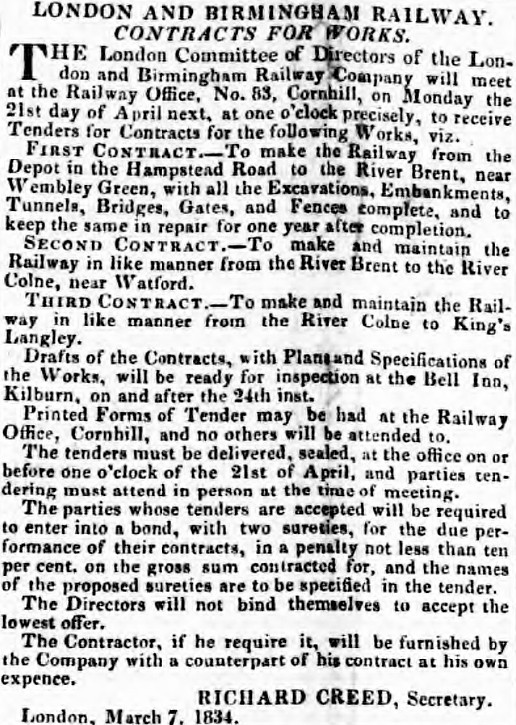
Stephenson spent the time between the passage of the London and
Birmingham Railway Bill (May 1833) and the letting of the first
three contracts (May 1834) assembling his project team, levelling and staking out
the course of the line, and drawing up plans
and specifications for every aspect of the work:
“The engineer wished to ascertain with
accuracy the amount of the work before him. To effect this, before
cutting a turf, he went over every inch of ground, and endeavoured
to calculate the exact cost of every operation necessary for the
accomplishment of his task . . . . In laying down the Liverpool and
Manchester Railway, George Stephenson had at the outset of the
undertaking only a general notion of the labour before him. The
details were not considered till their consideration could no longer
be deferred. Robert Stephenson saw that this plan of leaving each
day to take care of its own evils was little calculated for so vast
an undertaking as the London and Birmingham line.”
The Life of Robert Stephenson,
John Cordy Jeaffreson (1866).
With these preliminaries complete, the Company was in a position to advertise for tenders
to undertake the work, which had been
divided into sections, their extent depending on the complexity of the task.
For the reasons stated above, the Board stipulated that work was to
commence at the London end of
the line:
“In their former report, the Directors
announced the appointment of Mr. Robert Stephenson, as Engineer in
Chief. They have since succeeded, to their complete satisfaction, in
obtaining the services of a sufficient number of skilful and
scientific persons as Assistant Engineers, for conducting the Works
on every part of the Line, which has been arranged in sub-divisions
for this purpose.
Notwithstanding the obstacles which an unfavourable season has
presented to the field operations of the Engineers, the whole of the
Line from London to Birmingham has been staked out and levelled,
with the exception of a few points, to which Mr. Stephenson is
desirous of devoting his particular attention. He has requested
that the Plans and Specifications of the Works for the first twenty
miles from London will be complete by the 1st of March.
The Directors will then immediately advertise for Tenders for the
execution of the Works on that portion of the railway, and the Plans
and Specifications for other parts of the Line will follow in
succession as shall bring the remainder into completion, in
conformity with the intention announced in the former Report.”
Liverpool Mercury,
28th February, 1834.
Each sets of plans and specifications were produced in triplicate,
one copy being available for inspection by
potential contractors who, on the appointed day, submitted
sealed tenders for contracts in which they were interested. Tenders were then evaluated on the basis of experience and
reputation, price, and the adequacy of the contractor’s capital for
funding construction until payment became due from the Company for
completed work. Following the award of a contract, each of the sets
of documents were
signed by Stephenson and the successful contractor; one set went to
the Board, Stephenson retained a set, and a set went to the
Assistant Engineer for the district.
By August 1834, the
Company had let contracts for 42 miles of railway ― 21 miles at each end
of the line ― and the Board
was confident that before the close of the year contracts would have
been let for almost 80 miles. And so work commenced.
――――♦――――
ABANDONED CONTRACTS
If contemporary accounts are accurate, few of the works necessary to
surmount the landscape’s natural obstacles presented exceptional
problems, but those that did threw up challenges that were more than
the civil engineering contractors of the age could handle. During the course of construction, the Company was obliged to
revoke eight of the thirty contracts and make other
arrangements. The Castlethorpe and Weedon contracts were among those
re-let to other contractors, but a further eight were taken over by
the Company’s own engineers,
who then managed the work directly and provided the wherewithal to
complete it. Under these
circumstances, the Company was entitled to claim liquidated damages
for the additional costs arising from the contractor’s failure to
perform the contract, but this was not considered feasible:
“In reviewing the extent, and particularly
the nature of the country through which the Railway passes, no
person can be surprised that a vast number of unforeseen
difficulties should arise. In the progress of the works,
difficulties were developed which defeated the sagacity of the most
experienced contractors ― which set at defiance the knowledge of the
ablest engineers . . . .
. . . . The question has been asked,
Why
were not the securities of these contractors made to pay the fine
consequent on the breach of contract, and thus a portion of the
Company’s loss be recovered? The answer is plain: neither equity
nor sound policy could approve of such a line of procedure. If the
Company’s engineer, with all his experience, could not foresee these
hidden difficulties, how could a contractor estimate them? With such
discrepancies between the apparent labour, and that which, in
proceeding, was revealed, it would be a question for a jury, or
possibly the Chancellor, whether they would be liable. The attempt
to make them so would then have involved a law-suit, and its
consequent delay in the progress of the works ― a delay which would
be so injurious as to neutralise the benefits of a successful suit ―
a delay which, if the suit were unsuccessful, would have exposed the
Directors to a fearful responsibility. They, however, acted upon the
spirit of their contracts, and thus avoided the injury and the odium
which the reverse line of conduct would have ensured.”
The Railway Companion, from
London to Birmingham, Arthur Freeling
(1839).
Thus, the cost of building the line began to
rise significantly
above that estimated, although it is probably fair to say that none
of the contractors who did deliver what was expected grew rich in
the process. Speaking of the difficulties encountered during the
construction of the line, Robert Stephenson subsequently observed:
“After the works were let, wages rose, the
prices of materials of all kinds rose, and the contractors, many of
whom were men of comparatively small capital, were thrown on their
beam-ends. Their calculations as to expenses and profits were
completely upset. Let me just go over the list. There was Jackson,
who took the Primrose Hill contract — he failed. Then there was the
next length — Nowells; then Copeland and Harding; north of them
Townsend, who had the Tring cutting; next Norris, who had Stoke
Hammond; then Soars; then Hughes: I think all of these broke down,
or at least were helped through by the directors. Then there was
that terrible contract of the Kilsby Tunnel, which broke the Nowells,
and killed one of them. The contractors to the north of Kilsby were
more fortunate, though some of them pulled through only with the
greatest difficulty. Of the eighteen contracts in which the line was
originally let, only seven were completed by the original
contractors. Eleven firms were ruined by their contracts, which were
re-let to others at advanced prices, or were carried on and finished
by the company. The principal cause of increase in the expense,
however, was the enlargement of the stations. It appeared that we
had greatly under-estimated the traffic, and it accordingly became
necessary to spend more and more money for its accommodation, until
I think I am within the mark when I say that the expenditure on this
account alone exceeded by eight or ten fold the amount of the
Parliamentary estimate.”
The Life of George
Stephenson and of his son Robert Stephenson, Samuel Smiles
(1868).
Much had yet to be learned about estimating and
contracting for large-scale civil engineering projects, among which
was the impact on labour and material costs arising from other
railway projects competing for the same resources ― inflation was to
play its part in doubling the final bill for the line:
“Retardation of Railways by the High Price
of Labour. ― Owing to the great demand for labour the wages have
risen considerably, and increased obstacles are thrown in the way of
completing the lines which are in progress. The Birmingham,
Southampton, and other lines, we are informed, are not proceeding
with little more than half the rapidity they were. Of course this,
with the great rise in iron and other things, must tell materially
in the estimates, and tend much to retard that early benefit the
country would otherwise derive from these undertakings. Common
labourers are offered on the London and Birmingham Railway, from
fifteen to eighteen shillings per week, and masons four shillings
and sixpence per day, but even at these wages the application for
hands in many places has been unsuccessful.”
The Railway Magazine, Vol. 1
(1836).
“From the great increase in prices, which
took place almost immediately after the letting of the works, no
less than seven [eight]
contracts were thrown on the Company’s hands, and of course these
were the most difficult and expensive parts of the works, and in
each case, the directors had to purchase all kinds of implements and
materials at a vast expense, including five locomotive engines,
while, from the times at which these seven contracts took to
complete them, there was very little possibility of transferring
these implements (technically called the Plant) from one contract to
another. This, although a very expensive process, was the only one
to be followed, or the line could not be opened under at least a
year beyond the time contemplated.”
The London and Birmingham Railway, Roscoe and
Lecount (1839).

Construction contracts and the
eventual contractors (eight having failed),
from The Life of Robert Stephenson, John Cordy Jeaffreson
(1866). |
――――♦――――
|
THE BRENT CONTRACT
On 21st April 1834, the Company let three contracts covering the
first 21 miles from London. Messrs. Jackson and
Sheddon took the Brent (or Primrose
Hill) contract, a 5¾-mile section that included a deep cutting and tunnel
under high ground adjacent to Primrose
Hill, a tunnel at Kensall Green, and a long embankment across the
Brent Valley.
The Primrose Hill Tunnel was to be 1,120 yards long, 24 feet wide, 22 feet high,
with 5 shafts and
brick-lined throughout. The main problem for the
contractors lay in the nature of the terrain through which the
tunnel was
to be driven, blue London clay:
“The Brent contract, a length of six miles,
was let to an experienced contractor for the sum of £119,000; the
party failed, and the Company were obliged to do the work, which in
consequence of the peculiarity of the soil, has cost them £250,000. This contract included the Primrose-hill Tunnel, which is 1100 yards
in length, and proceeds entirely through what is termed London clay,
the most unmanageable and treacherous of all materials, the
difficulty of tunnelling through which can only be appreciated by
practical men. Unsuccessful attempts have been made to tunnel
through it at former times, the most memorable of which was the
Highgate Tunnel. The Primrose-hill Tunnel is, however, the largest
work that has ever been effectually performed through the same
material.”
The Railway Companion, from London
to Birmingham, Arthur Freeling (1838).
In the age in which the Primrose Hill Tunnel
(map) was built,
tunnelling in general remained fraught with difficulties, among which was
estimating its cost, as that at Kilsby was to prove. Excavation alone was expensive, but
especially so in London clay, which is a tough material and very
difficult to remove. Lecount states
that hatchets and cross-cut saws were the most effective tools, for
spades, pickaxes and blasting proved to be of little use.
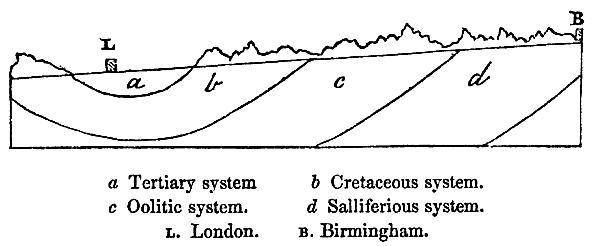
“The formation over part of which we have
come is called the London clay, and constitutes the lower
portion of what geologists call the tertiary
formation [from 65
million to 1.806 million years ago]. It consists of immense beds of argillaceous matter
resting above the chalk, which latter has, at some very remote
period, formed the floor of a gulph of the sea or bed of the mouth
of a large river, which has gradually been filled up by muddy
depositions, from 300 to 600 feet thick, now constituting the London
clay. The clay with which this chalk basin has been filled up, forms
the site of the British metropolis and neighbourhood; it extends on
the north and west to the Chalk Hills of Wiltshire, Berkshire,
Oxfordshire, Buckinghamshire, and Hertfordshire. On the east it
reaches to the sea, and on the south terminates at the North Downs.”
Osborne’s London & Birmingham
Railway Guide, E.C. and W. Osborne (1840).
A more acute difficulty associated with London clay was
already known, for some years previously the Highgate Tunnel, which
passes through the same terrain, collapsed. Its failure was attributed
to the immense pressure exerted by London clay when exposed to
air [1] and the inability of the tunnel’s brick lining to
withstand it:
“The London clay is penetrated by the
Primrose Hill Tunnel, and presents a close, compact, and dry
appearance. This tunnel was perfectly free from water, but a more
than usual thickness of brick lining was necessary, arising from
an extraordinary pressure, probably caused by the swelling of the
clay, on exposure to the atmosphere.”
The London and Birmingham Railway,
Roscoe and Lecount (1839).

Portal at Primrose Hill Tunnel under
construction, April 1837. John Cooke Bourne.
Towards the end of 1834, the Company
was obliged to take over the work from
Jackson and
Sheddon,
the contractors, who had become bankrupt.
In their place, Stephenson appointed John Cass Birkinshaw to take
over supervision:
“The London and Birmingham Railway was
commenced in the year 1834, and Mr. Birkinshaw was appointed
assistant engineer at the London or Camden Town end. But he did not
long retain that position, for the contractor having become
bankrupt, the works were carried on by the company, and Mr.
Birkinshaw, as having already had much experience, was considered by
Mr. Stephenson a proper person for their direction and management. The heaviest works were the Primrose Hill tunnel, made through the
London clay, the open-cut tunnel at Kensal Green, and the Brent
bridge, beyond which his portion of the line did not extend far. The
works were well done, and elicited favourable remarks both from Mr.
Stephenson and from the chairman of the company.”
From an obituary of John Cass Birkinshaw
(1811-67) held by the Institution of Civil Engineers.
|
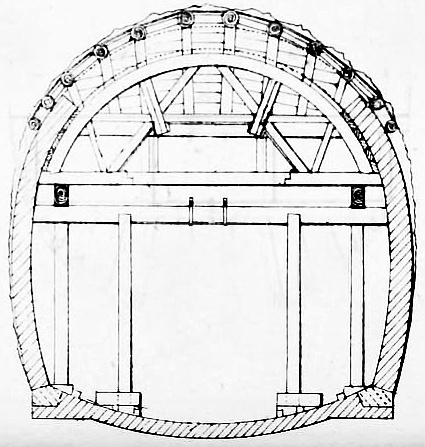 |
|
Section of Primrose Hill
Tunnel,
showing timbering and the brick invert (bottom). |
In view of the clay’s ability to exert substantial force as it expanded,
Stephenson and Birkinshaw adopted unusual precautions. Excavation was limited to nine feet in
advance of the tunnel’s brick lining, and very strong timbering was
used to support the arching until the brickwork was complete. Owing
to the extraordinary expansivity of the moist clay, the pressure
on the brickwork was such that it forced the mortar from between the
joints, bringing the bricks’ inner edges into contact, a
problem made worse by the local bricks having hollow surfaces that
made them unfit to bear great pressure. Lecount states in his history of the Railway that the
bricks were ground into dust and, by degrees, the tunnel’s dimensions
insensibly but irresistibly contracted. In his biography of the Stephensons, Samuel Smiles also refers to the problem:
|
“The pressure behind the brickwork was so
great that it made the face of the bricks to fly off in minute
chips, which covered his [Stephenson’s]
clothes while he was inspecting the work.”
Life of George Stephenson
and his son Robert Stephenson, Samuel
Smiles (1868). |
This difficulty was overcome using very hard bricks laid in Roman
cement, which, by setting hard before the external pressure became
great enough to force the bricks into contact, enabled the whole
surface of the brick to resist the pressure, rather than just its edges. The thickness of the brick lining was also increased in
most parts of the tunnel to twenty seven inches and the invert (an
inverted arch on the tunnel floor) to eighteen ― the invert, it
appears, had been abandoned as a cost-cutting measure:
“In the original designs for the tunnels on
the Loudon and Birmingham Railway, all the sections contained
inverts, of rather slighter
depth than the arch. In the Watford tunnel, through solid chalk, the
invert was found to be altogether unnecessary, and its place was
supplied by ordinary footings to the side walls. A similar change,
which was not only a saving of a large expense, but a means of very
considerably increasing the rate of progress of the limiting works
of the line, was accordingly attempted in the Primrose-hill tunnel;
but the hard London clay, though requiring a pick axe to cut it,
soon showed such unmistakeable menace of rising from the floor to
fill the whole excavated area, that the original section was
re-established.”
Personal Recollections of
English Engineers, F. R.
Conder (1868).
Other than the engineering problems thrown up by London clay, inclement weather also played its part in
delaying the tunnel’s completion and the opening of the
first section of the line:
“The Directors, in their late Reports,
expressed an expectation that the first 21 miles of the railway from
London would be completed in the spring of 1837. They regret to say
that, owing to the late unexampled season, this expectation cannot
now be realised before the summer. The engineer reports that the
continued bad weather for the last four months, defeated his
calculations in a degree which no former experience could have led
him to anticipate. In some descriptions of soil this delay could not
have taken place to such an extent as in the London clay, which
is exemplified by the progress of the works on other parts of the
line, where the material is more favourable; but in the London
district the incessant falls of rain have rendered it quite
impracticable to proceed with them uninterruptedly. With the
excavations and embankments on the Primrose-hill contract he
persevered until the extra expense was such as to induce him to
suspend further operations; a step, in the propriety of which, the
Directors fully concurred.”
Report of the 7th half-yearly General
Meeting, Northampton Mercury, 18th February 1837.
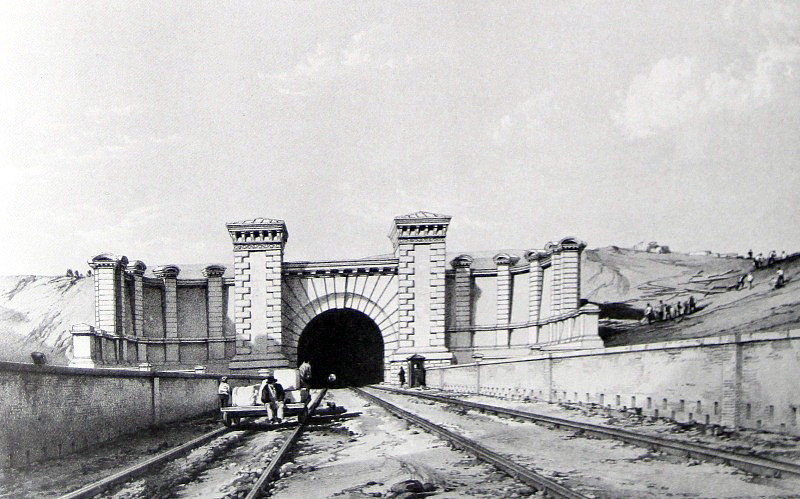
South
entrance to the Primrose Hill Tunnel by John Cooke Bourne, 1837.
“Leaving Kentish Town on the right, and
passing under Chalk Farm bridge, we enter the Primrose Hill cutting. If the traveller should now happen to look out from the window of
the carriage, he will behold stretching across the line the noble
entrance of the Primrose Hill tunnel. This is a bold and massive
structure, erected in that style of architecture which is usually
termed the Italian; and consists of two wings and a centre, raised
upon a rusticated basement.”
Drake’s
Road Book of the London and Birmingham Railway, James Drake (1839).
The
Brent section also included the 320-yard Kensal Green Tunnel,
probably the World’s first ‘cut and cover’ railway tunnel:
“Kensal Green Tunnel: The Railway passes
under the Edgeware Road and Kilburn Wells. At Kensal Green, a deep
cutting was made to pass under the Harrow Road, at a very acute
angle; after which the channel was covered over, and the roadway
newly made. This gallery, or covered way, called the Tunnel, at
Kensal Green, is 966 feet 6 inches in length.”
The Literary World, Vol. 2 (1840).
Judging from the absence of reports, the tunnel appears to have been completed
without serious incident, but that cannot be said for the embankment and
viaduct across the Brent Valley:
“Here
is a slight excavation of about 150 yards, which is succeeded by an
embankment of one mile and a half in length, which is, in some
places, from 35 to 40 feet high; under it is a small tunnel, two
field bridges, and what we must call the Brent Viaduct . . . . it is
85 yards long, and consists of one main arch, and three others in
each abutment; the former is 37 feet from the level of the river
Brent, which flows through it . . . . it is in some places nearly
forty feet in height, and it contains 101,923 cubic yards of earth.”
The Railway Companion, from London
to Birmingham, Arthur Freeling (1838).
This embankment was constructed from pieces of
broken up London clay,
but was not soundly compacted, leaving fissures within the structure
that gradually caused the interior to become saturated with rainwater.
The clay softened, resulting in
slippage:
“With
reference to that portion between London and Tring, the permanent
road is in tolerably good order, except on the Brent Embankment near
London and on the Colne Embankment near Watford. Both these works
have continued to subside, with scarcely any intermission, more or
less rapidly since their formation; the former from the slippery
nature of the material which composes it, the latter from the
unsoundness of its substratum in the valley of Colne. The gradual
subsidence of embankments admits of no other remedy than maintaining
the level of the railway by the constant supply of new sound
material adapted for ballasting, which in the present case may
fortunately be obtained from a convenient spot, and at a moderate
expense, for there is in the Company’s possession at the south end
of the Watford Tunnel, a large store of excellent gravel and chalk,
sufficient to meet all the demands of the line and stations between
Watford and London for some years.”
The Mechanics’ Magazine,
Volume XXVIII (1838).
Severe weather also delayed work on the Brent
Embankment (and also at Wolverton and Tring, where excavation of the long
Tring Cutting came to a standstill). Despite these setbacks,
at the General Meeting held in February 1837 the Chairman was able
to inform those present that the Brent contract was nearing
completion:
“The
works of the Primrose-hill contract, which have been continued by
the Company under the direction of the engineer, are nearly
completed with the exception of the Brent embankment. The
Primrose-hill and the Kensal-green tunnels are finished and
traversed by the Company’s engines, and the permanent way is laid
through a great part of this contract. Of the embankment on the
south side of the Brent bridge, about 58,000 cubic yards remain
unfinished, to complete which, under an ordinary state of the
weather, would require three months. That portion of the embankment
which is north of the bridge is brought up to it, but not yet raised
to the railway level. On the completion of the embankment north of
the Brent, the engineer proposes to expedite the formation of the
south portion of it by making 6,000 or 8,000 cubic yards of side
cutting, thus guarding against further disappointment as far as
practicable.
From this point to Watford no work appears to require especial
mention, the completion of the Watford tunnel and the small quantity
remaining in the excavations at each end, rendering any detailed
remarks on this part of the line unnecessary.”
Report of the 7th half-yearly General
Meeting, Northampton Mercury, 18th February 1837.
The Primrose Hill Tunnel was eventually completed in January 1837 at a cost of £280,000,
over twice the contract price, but despite the Chairman’s optimistic
forecast for completion of the Brent Embankment, tipping and
compacting more material to counter slippage was still proceeding in
1838.
|
――――♦――――
|
THE WATFORD EMBANKMENT AND VIADUCTS
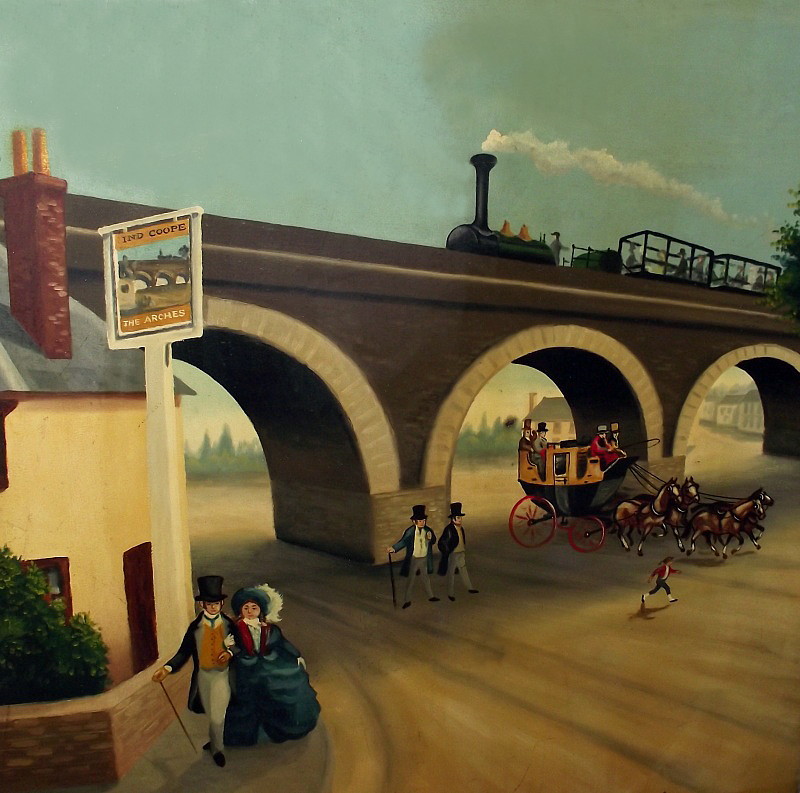
The ‘Bushey
Arches’ viaduct near Watford ― a public house sign, now in Watford
Museum.
The second of the London contracts covering the section from the River Brent to the
River Colne was let to Nowell & Son. This work, which included
a cutting
through the Oxhey Ridge ― the original plan being for a tunnel
― does not appears to have presented
any particular engineering challenges:
“Mr. Stephenson reported that from the
nature of the soil at the proposed Tunnel under Oxhey Lane,
and from the comparisons of Messrs. Nowell & Sons prices for
tunnelling in the Schedule of extras and the prices of excavations,
he considered it would be for the advantage of the Company that this
portion of the Line should be made an open cutting. That
Messrs. Nowell & Sons were willing to substitute the excavation for
the Tunnelling without any additions to the sum for which they have
contracted.
Minute No. 179. Resolved that the Engineer-in-Chief be
authorised to make necessary arrangements with Messrs. Nowell &
Sons, and that the portion of land at Hatch End required for spoil
be reserved for that purpose.”
Board Minutes, 24th September
1834.
The completed Oxhey cutting impressed one travel writer sufficiently to prompt
him to pen a description:
“On the left appears Oxhey Ridge. This
ridge is part of a chain of hills which extend from Chipping Barnet
to Uxbridge, and for a considerable distance form the boundary
between Middlesex and Hertfordshire. The materials of which they are
composed are principally sand and clay; and it was on account of the
difficulty of carrying a tunnel through such a description of
ground, that the railway was made to cross them by a cutting,
notwithstanding their great elevation. In passing through this
excavation, we cannot avoid being struck with astonishment at the
immense amount of labour which its construction must have required;
it being a mile and a half in length, and in many places between
thirty and forty feet deep. It is crossed by several bridges, the
principal of which is Oxhey lane bridge, a noble structure of three
arches, but attracting attention chiefly by its extraordinary
height. A short opening which occurs immediately after passing this
bridge enables us to catch a glimpse of Oxhey Wood; and, upon the
termination of the cutting, we behold amid some prettily wooded
scenery on the left the little village of Oxhey, with its antiquated
chapel and remarkable churchyard, ― remarkable, indeed, if we may
place any credit in the asseverations of a rustic, who solemnly
assured us that its silent denizens were wont to be buried in a bolt
upright posture.”
Drake’s Road
Book of the London and Birmingham Railway, James Drake (1839)
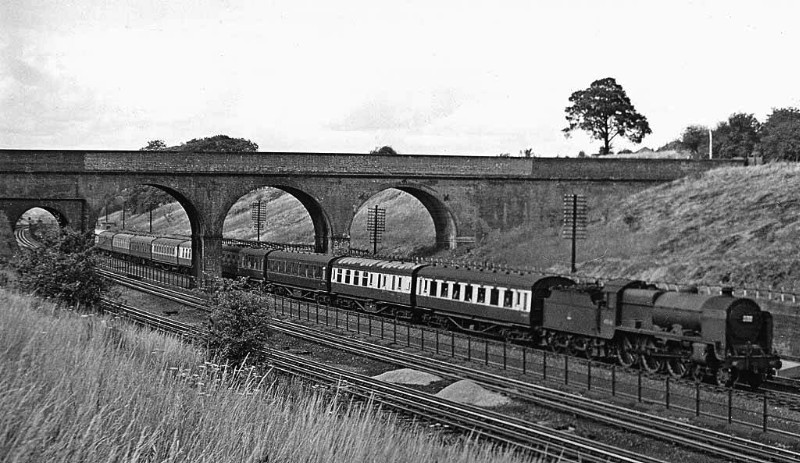
Oxhey Lane Bridge
in a later era.
The contract also included the
southerly of the two
mainline viaducts [2] in the Colne Valley,
the London-road viaduct, known locally as the ‘Bushey Arches’. This
is a 5-arch structure of which the arch spanning the former
‘Sparrows Herne’ turnpike (Bushey Heath to Aylesbury) is the first
skew arch to the design of Assistant Engineer George Watson Buck:
“Soon after entering upon it
[the Watford embankment] the Railway
goes over the London road, by a brick viaduct of five arches, of
forty-three feet span each; they are composed of ellipses, having voussoirs at the intrados; [3]
the centre arch is of an oblique form, in order that the course
of the road should be preserved as heretofore. This may be thought a
bad feature in a design of this kind, but it was unavoidable, the
trustees having compulsory clauses in the Act of Parliament to
compel the Company to adopt this form of arch. The manner in
which the engineer has overcome the defect in the design is
admirable, and it is scarcely perceptible to the observer: it is a
very massive structure, and cost in its erection £9,700. The other
arches are square with the line of Railway; and at either end are
retaining walls built into the embankment, making the total length
of the viaduct three hundred and seventy feet.”
The
London and Birmingham Railway, Roscoe and
Lecount (1839).

The London Road
Viaduct’s skewed arch.
|
“Mr.
Stephenson reported that one arch of the Watford Bridge
is turned and that another is nearly so, and that a
third, a skew arch, is in such a state of forwardness
that he expects the whole to to completed in two months.”
Board minutes, 26th
November 1834.. |
The London-road viaduct is followed by a 1½-mile long embankment, the
River Colne being bridged by the 5-arch ‘Colne Viaduct’ ― both
embankment and viaduct threw up
engineering challenges.
The problem that the contractors faced
with the Colne embankment lay not in the use of unsuitable material
from which to form it, [4] nor in excessively
steep slopes, but in the valley’s weak sub-stratum that was unable to
withstand the loading. As with the Brent embankment the only
remedy was to continue tipping material until the formation
stabilised:
“It
has been found useless to remove the bog, on account of the water it
contains, and the only alternative is therefore to allow the
embankment to proceed and settle as it may. It is very low
near the ends, and descends rapidly and somewhat irregularly; the
men ought to be constantly cautioned against their danger in taking
off the horses from the [earth]
waggons, and are much exposed to going over. The brakes
however are simple and well managed.”
Report to the Visiting Committee, 27th and 28th May, 1836.
“The
Sub-Committee had the satisfaction to find that the Embankment at
Watford, under Messrs. Nowell's, was proceeding in conformity with
the directions of the Committee, that the Bog earth was removed and
replaced by sound material from the side sutting, and that the
embankment was in consequence assuming the necessary stability.
The difficulties at this point are not likely to retard the
completion of the first 21 miles of the Railway.”
Report to the Visiting Committee, 1st and 2nd September 1836.
“It
took nearly one million cubic yards of earth to make this
embankment, which is in some places above forty feet in height and
is the largest throughout the whole line . . . . The
whole of the land near this spot is most precarious in stability;
and the effects are clearly visible in the amazing ‘slips’ which
have taken place in the embankment across the [Colne]
valley. Oftentimes, in a very few hours, the level of the
newly-formed ground has sunk several feet, while the base of the
embankment has widened out to an enormous extent, causing infinite
labour to bring the level of the Railway back again to its original
state, and to make it solid enough for the passage of the trains;
this has caused many a sleepless night to the workmen and engineers.
The length of this embankment is about a mile and a half, and is
composed entirely of the finest materials for such a purpose ― chalk
and gravel.”
The London and Birmingham
Railway, Roscoe and Lecount (1839).
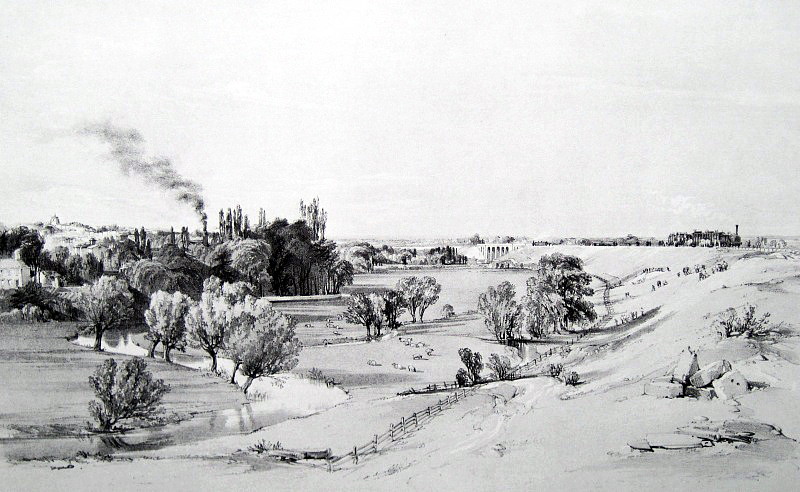
The Colne Valley embankment
and River Colne Viaduct,
by John Cooke Bourne (1837).
Note the abandoned stone
sleepers, right foreground above.
And the same problem affected the
viaduct over the Colne. Both Conder and Lecount recalled the
considerable excavation that was necessary to find firm ground on
which to rest the viaduct’s piers:
“. . . . long trains of brick-carts and
timber-carriages commenced a service from the nearest canal wharf,
and piles of bricks, and heaps of half-wrought freestone from
Yorkshire quarries, began to accumulate near the waggon-building
field. Then there was a great-field day of the engineers, a display
of lines and levels and measuring tapes, an arbitrary infringement
on the turnpike road, and the foundations of the great new viaduct
were commenced. It was necessary to press this work as rapidly as
possible, as some million and more cubic yards of embankment had to
be carried over it and tipped to form the southern portion of the
great Colne Valley Embankment. For seventeen feet the workmen had to
sink, before arriving at a foundation sufficiently firm to sustain
the weight of the piers.”
Personal
Recollections of English Engineers, F. R.
Conder (1868).
“The construction of this bridge
[the viaduct]
was a work of considerable skill and labour, the foundations being
of the loosest material possible; in fact, it may almost be called a
floating bridge ― for it rests entirely on platforms of wood, having
sheet piling to protect them. The cost of its construction was
little less than £10,000.”
The
London and Birmingham Railway, Roscoe and
Lecount (1839).
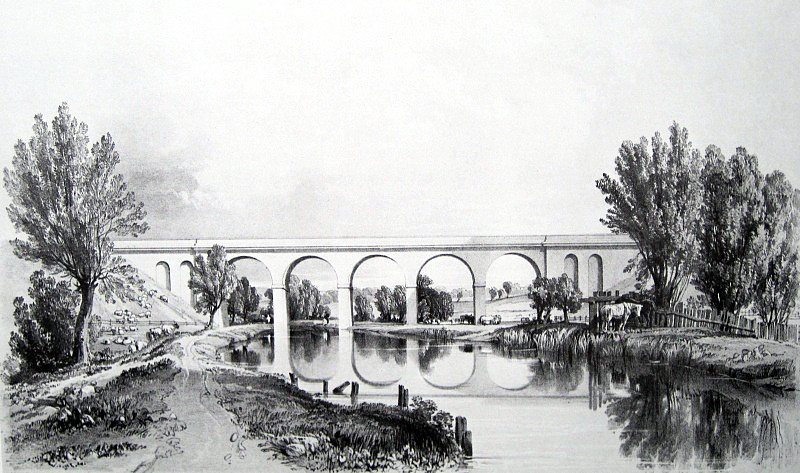
The Colne
Viaduct, by John Cooke Bourne (1837).
|
――――♦――――
|
THE WATFORD TUNNEL
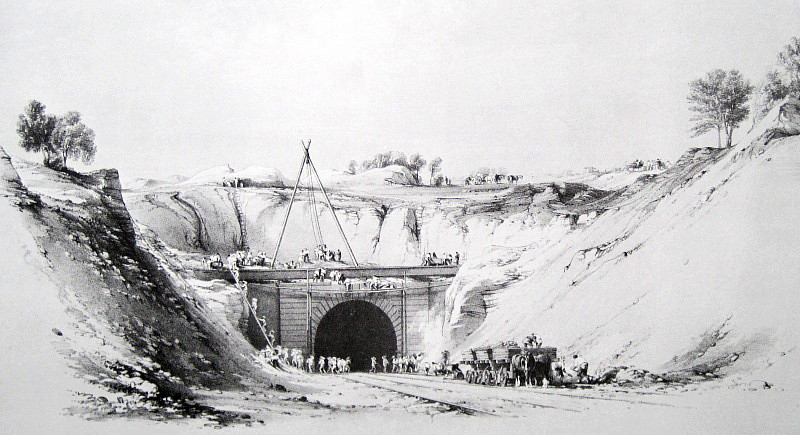
Watford Tunnel face, 6th June
1837, by John Cooke Bourne.
Stephenson’s
original plan was to route the line to the west of Watford
and into the Gade Valley; then,
to proceed northwards in close company with the Grand
Junction Canal to Hunton Bridge where the line would have joined
the existing route. However, the Earls of Essex
and of Clarendon, landowners of the Cassiobury and Grove estates
through which the line was to pass, were implacably opposed to
this scheme (and, indeed, to the Railway as a whole). Thus, as
an alternative, George Stephenson & Son submitted a report
recommending that the line pass to the east of Watford and then
northwards through what is now the long Watford Tunnel:
“The alteration at Cassiobury as an expedient
to avoid the private grounds of Lords Essex and Clarendon is
unquestionably an expensive one, but after thorough examination of
that neighbourhood keeping in view the necessity of avoiding
Cassiobury Park and the adjoining plantation belonging to Lord Essex
we are inclined to recommend the adaption of it, though it involves
the necessity of a Tunnel.
This leads us to notice the circumstances of Tunnels occurring in
the line we are now recommending. It is certainly desirable to
avoid such mode of surmounting high grounds if it were practicable
at a moderate expense but we are induced to recommend Tunnels in
some situations when the depth of the cutting is very great in order
that the first cost of the line may be greatly diminished.”
Report dated 21st
September 1831.
In evidence given before a
Committee of the House of Lords, Stephenson expressed his feelings
plainly on the
need for this deviation:
“I have been nearly two years examining the country for the
proposed line to Birmingham, which begins at Oxhey Lane and goes
from thence to the South end of Watford, through the Colne valley,
and passes the parks of Lords Clarendon and Essex, avoiding the
same by a tunnel and an acute curve, which would be attended with no
inconvenience . . . .”
Abstract of Evidence given
before a Committee of the House of Lords, June 1832.
The Watford Tunnel and its two deep approach cuttings formed part of
the contract let to Copeland and Harding, which covered the section from the
southern end of the Colne crossing to King’s Langley:
“Just past here is the entrance to the Watford Tunnel; it is 24
feet wide, and the crown of the arch is 25 feet high; it is
ventilated by six shafts, the largest of which is a memorial of the
death of the persons buried here during the excavation; the shaft was
increased in size to get out their bodies; the tunnel is one mile
170 yards in length; upwards 120,000 cubic yards of earth were taken
out of it.”
The Railway Companion, from
London to Birmingham, Arthur Freeling
(1839).
“. . . . I made my escape into the wider,
though more reasonable, turmoil of the tunnel. There was no day
there and no peace: the shrill roar of escaping steam; the groans of
mighty engines heaving ponderous loads of earth to the surface; the
click-clack of lesser engines pumping dry the numerous springs by
which the drift was intersected; the reverberating thunder of the
small blasts of powder fired upon the mining works; the rumble of
trains of trucks; the clatter of horses’ feet; the clank of chains;
the strain of cordage; and a myriad of other sounds, accordant and
discordant. There were to be seen miners from Cornwall, drift-borers
from Wales, pitmen from Staffordshire and Northumberland, engineers
from Yorkshire and Lancashire, navvies — Englishmen, Scotchmen, and
Irishmen — from everywhere, muck-shifters, pickmen, barrowmen,
brakes-men, banksmen, drivers, gaffers, gangers, carpenters,
bricklayers, labourers, and boys of all sorts, ages and sizes; some
engaged upon the inverts beneath the rails, some upon the drains
below these, some upon the extension of the drifts, some clearing
away the falling earth, some loading it upon the trucks, some
working like bees in cells building up the tunnel sides, some upon
the centre turning the great arches, some stretched upon their backs
putting the key-bricks to the crown — all speaking in a hundred
dialects, with dangers known and unknown impending on every side;
with commands and countermands echoing about through air murky with
the smoke and flame of burning tar-barrels, cressets, and torches. Such was the interior of Watford tunnel.”
‘Navvies as they used to be’, from Household Words, Vol. XIII., 19th January 1856.
At Watford, the terrain becomes predominantly chalk, but soft
chalk rent by gravel-filled fissures as much as one hundred feet
deep:
“The gravel is most abundant in the neighbourhood of Watford,
covering the upper chalk which in many places it penetrates, or in
other words, the large fissures or rents in the chalk are filled
with gravel, and as this latter material is very loose and mobile,
it was the occasion of much difficulty and danger in the excavation
of the Watford tunnel; for at times, when the miners thought they
were excavating through solid chalk, they would in a moment break
into loose gravel, which would run into the tunnel with the rapidity
of water, unless the most prompt precautions were taken.”
The London and Birmingham Railway,
Roscoe and Lecount (1839).
These fissures were cut into on several occasions, but on the 17th
July 1835 there occurred an inrush of gravel at the foot of one of
the working shafts that buried alive ten of the miners at work in the
tunnel:
“The shaft in question, one of the four in this length of tunnel
(1,700 yards), is termed a gin-shaft, and has been sunk about 90
feet below an elevated platform erected for the purpose of removing
the earth. The shaft has been very lately sunk, and two nine-feet
lengths of tunnel had been bricked, the third being, it is stated,
just mined and ready for the bricklayers. The shaft was about to be
bricked on Friday morning, between 5 and 6 o’clock, by a party
consisting of five bricklayers and six labourers, who composed what
is termed the night gang; and had the appalling event taken place a
few hours afterwards, the morning gang would have been at work, and
the loss of human life must have been awful in the extreme . . . .
In loosening a portion of the wood work previous to bricking the
shaft, it is supposed the earth gave way and buried the unfortunate
men, carrying the whole of the wood work with it . . . . The men
must be buried upwards of 80 feet below the surface of the earth,
and although 60 men are actively engaged in digging out the bodies,
it is probable that six or seven days will elapse before they are
extricated.”
The Bucks Herald, 25th July
1835.
“After more than a month of incessant exertions on the part of
Messrs. Harding and Copeland, the contractors for the Watford line
of the London and Birmingham Railway, and a vast number of labourers
who were relieved every twelve hours, the bodies of some of the
unfortunate men, who were buried under more than eighty feet of
earth, by the sudden falling in of the shaft in Russell Wood,
Levesdon Green, Watford, in this county, have been dug out. Early on
Saturday morning the miners were enabled by crawling between the
interstices made by the fallen timbers, to see the legs of some of
the sufferers, and to know that before many more feet of the gravel
and chalk had been removed (the distance from the surface being
about eighty-four feet) they would come to the bodies . . . . At
three o’clock in the afternoon an extended hand presented itself to
the view of the bystanders, on the side of the opening opposite to
that which the first eruption of the gravel is supposed to have
taken place. The body on being cleared was found in a sitting
posture, with the head thrown back; it is presumed the poor fellow
was looking upwards at the moment he met his death, have heard the
cry of “ware” from the men at the top of the arch; his face was
crushed and the legs broken.”
The Bucks Herald, 22nd August
1835.
In view of the risk of tunnelling through such hazardous terrain,
the workforce was reluctant to continue. Many years later, Francis
Fox, son the Charles Fox, the tunnel’s Resident Engineer, recalled
his father’s strategy for getting the men back to work:
“Whilst engaged in the construction of the Watford Tunnel in
1834, he received instructions to go to Birmingham. He asked to be
allowed to remain, for they were working in very soft and dangerous
ground; but his request was declined, and he was sent to Birmingham.
He had not been gone more than a few days when a message was
received that the tunnel had fallen in, and eleven men had been
killed. He immediately hurried back, and found that there was a
panic on the spot. Up to this point is what my father himself told
me, but a very old friend of mine further related that, when the
tunnel had fallen in and had produced this panic, my father went to
the works and said to the men, ‘That tunnel has to be put through,
cost what it will, and therefore I want you men to volunteer.’ Not
one of them would do so. ‘Very well,’ he said, ‘I will do it’; and
he got into the bucket, and was just about to be lowered down the
shaft, when the ganger, using language more strong than elegant,
said he ‘would not see the master killed alone.’ He went down with
him, and these two finished the length through the dangerous ground,
after which the men returned to work.”
River, Road, and Rail ― some
engineering reminiscences, Francis Fox MInstCE (1904).
By February 1837, the Chairman was able to report that all that
needed to be done on the Watford Tunnel was a small amount of work
on the excavations at either end. |
――――♦――――
|
KINGS LANGLEY TO CHEDDINGTON
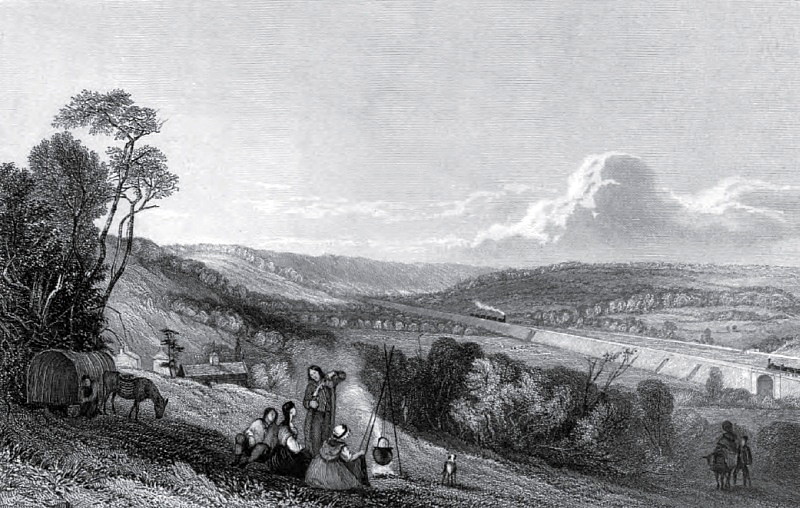
A romantic view
over Boxmoor looking towards Berkhamsted.
The contracts for the Kings Langley to
Aldbury [5] section were let to ‘W. & L. Cubitt’, a
name connected with many notable Victorian construction projects
including the 1-mile Camden Town to Euston
railway extension, and both Euston and King’s Cross stations. Although
there were no engineering problems of note on this section, it
included several interesting features; the fine iron skew segmental
arch bridge across the Grand Junction Canal at
King’s Langley (alas, now
defaced in concrete reinforcement), a masonry skew bridge at
Boxmoor, Boxmoor embankment, the
long retaining wall adjacent to Berkhamsted Castle and the Northchurch Tunnel.
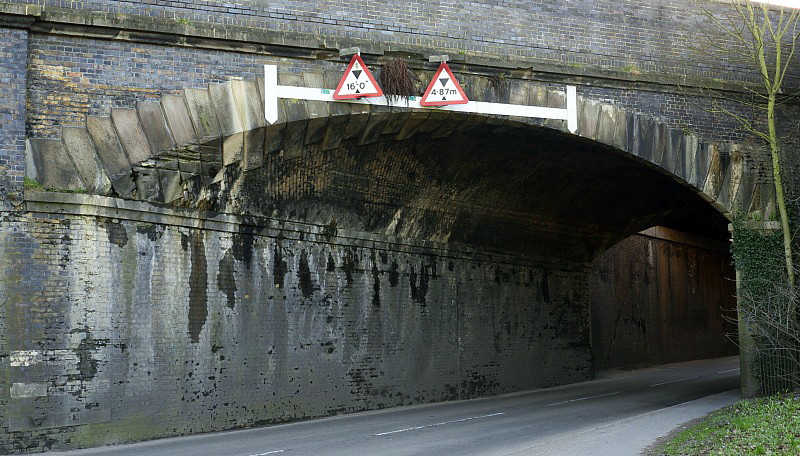
George Watson Buck’s masonry skew arch bridge at Boxmoor.
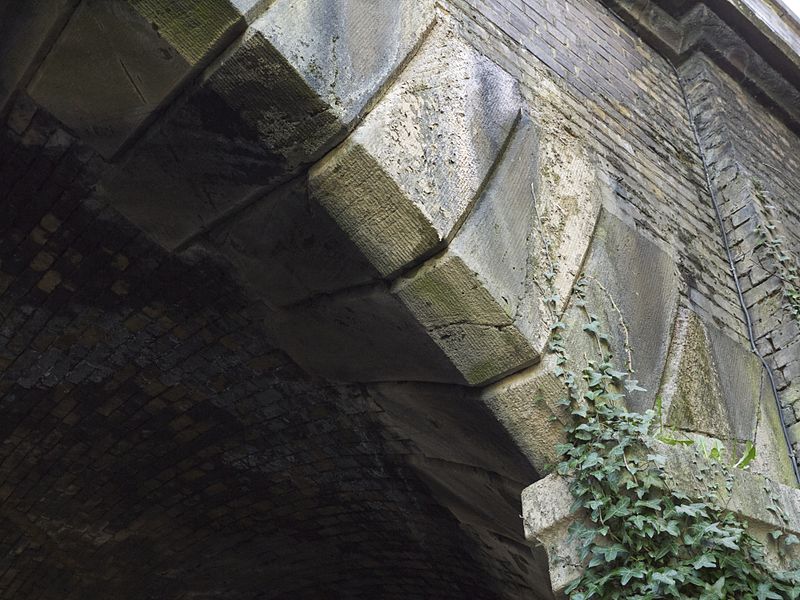
Referring to this bridge, Roscoe and Lecount were of
the opinion that . . . .
“The science of bridge
building has, of late years, made rapid strides towards
perfection, and there are many instances where arches of
immense span have been erected; but we believe no
example exists of such an oblique arch executed in brick
work as that now under notice. The square span
across the road is twenty-one feet; but the obliquity
causes the span on the face of the arch to be lengthened
to more than thirty-nine feet; its facial form is that
of a flat segment of a circle; and the acute angle of
the quoins is chamfered off until it reaches the obtuse
angle, where it vanishes. This gives the bridge the
appearance of having one voussoir more than it really
has; and also obviates the defects which generally
attend the construction of skew bridges, by the acute
angles of the quoins being broken off or injured, either
by settlement or accidental blows. The idea of cutting
off the acute angles of such arches emanated, we
believe, from Mr. George Buck, the resident engineer of
the line from London to Tring. The perfect manner in
which the whole of the stone work, and the spiral
courses of the bricks, are executed, reflects great
credit upon the builders, Messrs. Cubitt of London.”
At Berkhamsted . . . .
“. . . . work had begun in 1834 with a
massive earthmoving operation needed to take the line across the
outer moat of the Castle, and huge quantities of bricks were needed
to make a stable base (Birtchnell 1972, 87). The original station (Birtchnell
1975, xiii, 22-3) was a handsome brick building in Elizabethan
style, and stood almost opposite the Castle Street canal bridge. It
was replaced in 1872 prior to the widening of the tracks . . . . ”
Extensive Urban Survey ―
Hertfordshire: English Heritage and Hertfordshire County Council
(2005).
Berkhamsted Castle is said to be the first building to receive what
in today’s language would be described as a ‘preservation order’. Sections 98 and 99 of the 1833 Act stipulated that the Railway was
not to deviate from the authorised line (100 yards in either
direction was usually permitted) when passing through the grounds of
Berkhamsted Castle, neither were any structures ― except for
the necessary bridges, culverts, etc. ― to be erected, while section 100
forbad the Company from making bricks or burning lime anywhere
within the parish.
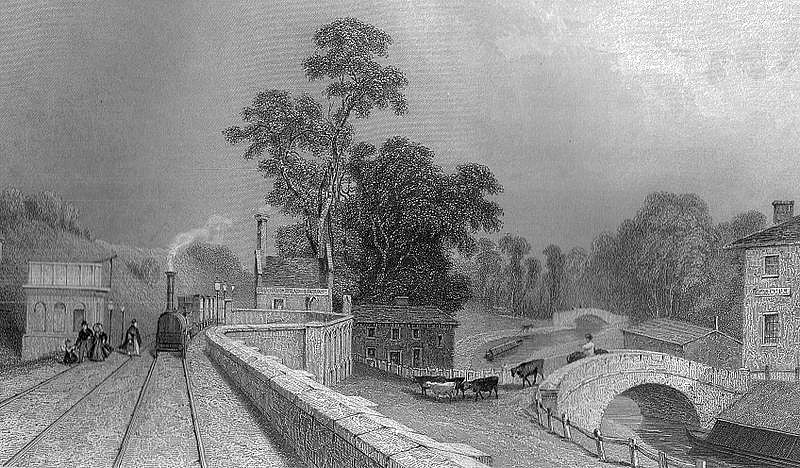
The original Berkhamsted Station.
The Grand Junction Canal is to the right in the picture
― note the absence of platforms.
At this point the Railway passes between the Canal and Berkhamsted
Castle atop
the substantial retaining wall in the foreground.
Nevertheless, the Railway cut through the Castle’s outer gate and
earthwork defences, running atop a substantial retaining wall, the
requirements for which Brees cites as a model for specifying
railway construction work. This is an extract:
“RETAINING WALL AT BERKHAMPSTEAD CASTLE.
“This Wall is for the purpose of retaining the Railway Embankments
along the part of the road from Berkhampstead to Berkhampstead
place, immediately in front of the Castle. Pilasters are to break
forward half a brick from the face of the wall, at a distance of 20
feet, as near as may be, centre to centre, and they are to run flush
into the plinth at the bottom, which must project half a brick. The
top course of the Plinth must consist entirely of headers, neatly
bevelled off, and laid in cement. A piece of stone, of the
dimensions and form shown, is to stand out as a string-course from
the pilasters, and in the manner shown in the drawings, and along
the wall, at the same level, a half brick projection of equal depth
is to be continued, the bricks of which must be rubbed on the outer
surface. Where the road passes under the Railway, this arrangement
is altered, as will be seen from the drawings. A torous moulding
extending as far as the outside of the pilasters in front of the
abutments. Immediately behind the pilaster, the wall must be broken
by counterforts, of the form and dimensions shown in the drawings,
and they must be well bonded into its substance. The footings are to
be carried down 1 foot 6 inches below the present surface, and
whatever is the section of the ground, they must in no part be
formed at a less depth . . . .”
Railway Practice: a collection of
working plans and practical details, S. C. Brees (1847).
From Berkhamsted, the line continues northwards along the Bulbourne
Valley in close company with the Grand Junction Canal, through
Northchurch and Dudswell towards its summit and the long cutting
through the depression in the ridge of the Chilterns known as the ‘Tring Gap’:
“We now enter the Dudswell excavation; it
is in some places fifty-three feet deep, and, including the tunnel,
three quarters of a mile in length, of which the North Church Tunnel
is nearly one half; the road from Ashridge to North Church passes
over the tunnel . . . . The traveller will have observed one
peculiarity in this excavation; from the nature of the soil; and the
depth of the excavation; it was found necessary to make a platform,
or gallery, about half way up; this is about ten feet in width, and
then the slope again commences; this platform gives great security
to the slopes, and prevents their falling in; the following diagram
will give a better idea than mere description.”
The Railway Companion, from
London to Birmingham, Arthur Freeling
(1839).
Although Freeling and Roscoe both refer to the ‘Dudswell
excavation’, it is at Northchurch where the cutting
― approaching a mile in length ― commences, deepening as it
approaches the
high ground at its northern end under which it passes through the Northchurch Tunnel. Both Freeling and Roscoe refer to the slopes of
the cutting being divided by a ‘bench’, which Freeling depicts thus:
“The upper strata of the Dudswell
excavation are formed of wider slopes than the lower portion, owing
to a different nature of the soil; and it also has a bench where
they unite, to give security to the slopes.”
The London and Birmingham Railway,
Roscoe and Lecount (1839).

“Bench, or Berm: a ledge left
on the face of a cutting to strengthen the same. Steep cuttings
should always have ledges to support them, particularly in canal
work to prevent the mould from the upper part, falling down into the
water; chalk may also be executed at a very steep inclination by
their assistance. Ledges are likewise generally made at a change of
slope, occasioned by meeting with a different soil.”
A Glossary of Civil Engineering,
Samuel Charles Brees (1841).
The Tunnel is probably better known than would otherwise be the case
through publication of the charming watercolour of its southern
portal under construction, by the artist and civil engineer Samuel Brees
(1810c.-65):
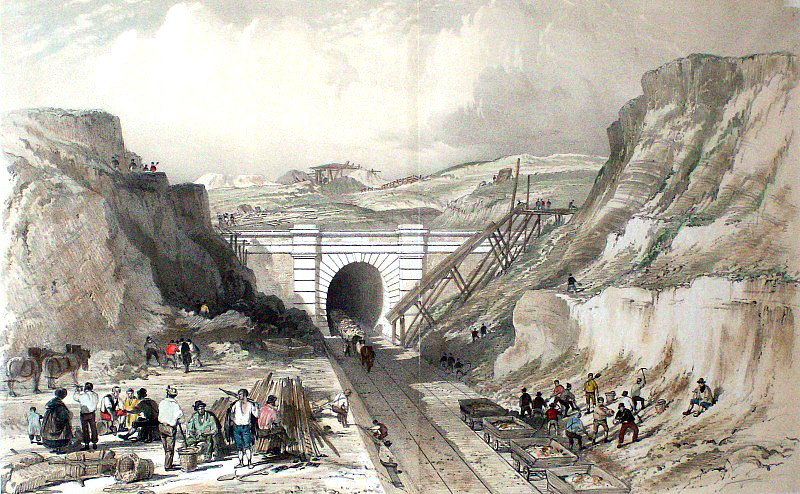
Northchurch Tunnel, September 1837. A
watercolour by S. C. Brees.
The contractor was W. & L. Cubitt.
“At about the middle of it we pass through
the North Church Tunnel, the length of which is one fifth of a mile.
It has two handsome fronts of stone, with side walls of brickwork,
and is the same height and proportions as the Watford Tunnel.”
The London and Birmingham Railway,
Roscoe and Lecount (1839).
Brees also reproduced the specification and
plans for the tunnel in the first edition of his series of books on
Railway Practice, from
which the following elevations are taken:
|
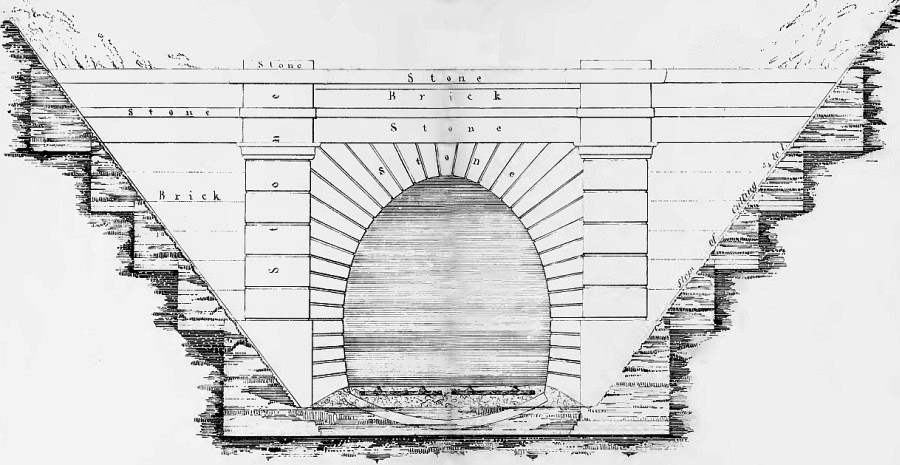
An elevation from Stephenson’s
plans for the Northchurch Tunnel,
reproduced in Railway Practice by S. C. Brees
(1838).
|
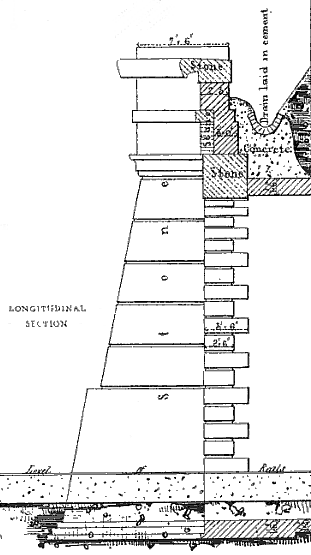 |
|
Northchurch Tunnel
portal,
reproduced in
Railway Practice by S. C. Brees
(1838). |
|
“This Tunnel is to consist of a brick Arch,
of the form shewn in the drawings, supported by carved Side Walls,
standing upon stone skew backs, which are to be bedded upon the
counter or Inverted Arch, forming the base of the tunnel: this part
is to be one and a half brick in thickness, excepting the shaft, as
shewn on next drawing, and the arch and side walls are to be two
bricks thick throughout the whole length of the tunnel, excepting
for a length of 7 feet 3 inches at the front, and at a distance of
12 feet on each side of the shaft, together with the shaft length,
where they will be three bricks thick, or in such other places as
the Engineer may think it requisite to make them thicker: in which
latter case the Contractor shall be paid for the increase according
to the rate mentioned in his Schedule of Prices. The Arch, if of the
thickness of one and a half brick, shall consist of three half brick
rings: if it be two bricks thick, it shall consist of four and a
half brick rings, and so on, and each ring shall contain five
courses of bricks more than the ring immediately beneath it . . . .”
An extract from Stephenson’s
specification for Northchurch Tunnel, from Railway Practice by S. C. Brees
(1838). |
The document went on to specify that excavation was to proceed in
what by then was the usual manner, of sinking shafts at intervals
along the tunnel’s alignment, from the bottom of which a narrow
heading was then excavated for the tunnel’s full length before
widening out commenced. The heading served to prove the correct
level and alignment, and help reveal any unexpected hazards that had
not been detected by trial boring:
“The Contractor must also sink two other
shafts on the centre line of the tunnel, one at each end of it, and
drive a Heading 4 feet wide and 5 feet high, the whole length of the
tunnel. This Heading must be carried through, before any part of the
main tunnel is commenced, and must be supported and kept open during
the execution of the whole work, by timbering or such other means as
may be deemed necessary by the Engineer . . . .”
An extract from Stephenson’s
specification for Northchurch Tunnel,
from Railway Practice by S. C. Brees
(1838).
Although Northchurch Tunnel appears to have posed no particular
civil engineering challenges during its construction, that does not mean
that the excavation was free of hazards for those who undertook the
work. But in that era, injury and loss of life in the workings was probably to be expected at some
stage during tunnel excavations:
“Frazer accordingly put in for, and
obtained a contract to carry a portion of the drift through
Northchurch tunnel; over this job he appointed George his gaffer,
and George then got me to be appointed his assistant and
time-keeper. So to Northchurch tunnel we went, early in October;
and, under the directions of the engineers, opened the drift at the
north end of the tunnel; sinking a shaft about midway on our length,
which was, I think, about one hundred and fifty yards. By the middle
of November we had six gang of navvies at work . . . . The soil
through which we were carrying the drift of Northchurch tunnel was
of a most treacherous character, and caused many disasters. Despite
every precaution, the earth would at times fall in, and that, too,
when and where we least expected. Thus, in the fifth week of our
contract, notwithstanding that our shoring was of extra strength and
well strutted, an immense mass of earth suddenly came down upon us. This came from the tapping of a quicksand. One stroke of a pick did
it. The vein was shelving and the sand, finding a vent, ran like so
much water into the open drift; which was of course speedily choked
up. George Hatley was at once on the spot; and, under his directions
efforts were promptly made to clear away the sand, so that the
shoring should be re-strengthened if possible before the earth above
(deprived of the support afforded by the sand) should collapse. The
most strenuous efforts were made in vain. There came a low rumbling,
like the distant booming of artillery, then followed crashes louder
than the thunder, startling us from our labour; and, while we were
hurrying away, down came the whole mass of earth, masonry, timber,
and sand, crushing five men under it.
Of these men three were dug out alive, and removed — terribly
mangled — to the West Herts Infirmary; the other two were found
dead.”
‘Navvies as they used to be’, from Household Words, Vol. XIII., 19th January 1856.
This article is reproduced in full in the
Addenda.
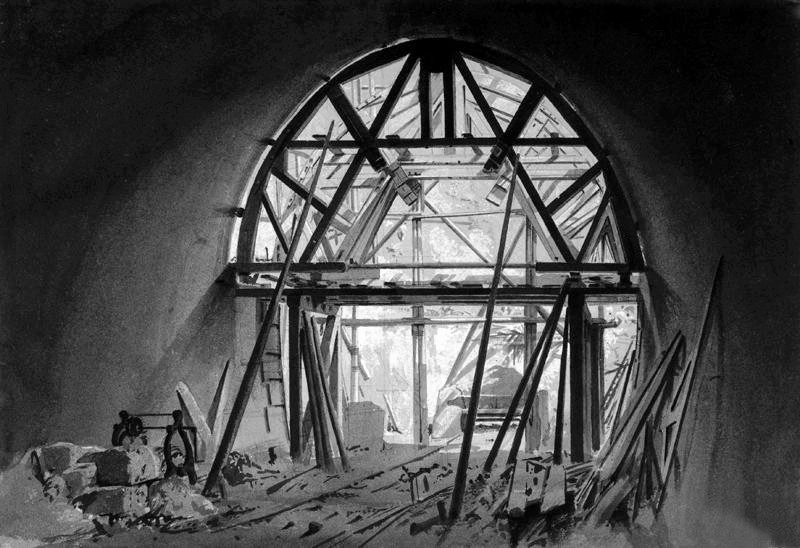
Northchurch Tunnel under
construction, June 17th 1837, by John Cooke Bourne.
The original West Herts Infirmary was founded by the eminent
surgeon, Sir Astley Paston Cooper, one of the Railway’s most
implacable opponents. [6] The hospital opened in
January 1827 for the “gratuitous relief of the necessitous poor”.
Construction of the London and Birmingham Railway
inevitably added to the hospital’s work, which by this time had moved from its small
beginnings to larger premises in Hemel Hempstead. The Railway
Company Directors donated £21 and the Contractors a further £25, but
they later arranged to pay 8s. a week for any workman admitted. Delay in treatment ― especially for men excavating the Tring Cutting
― could result in death from loss of blood, and the Hospital staff
suggested that gangers should be shown how to apply a temporary
tourniquet.
On emerging from the Northchurch Tunnel, the line continues its
ascent through Dudswell to Tring where it reaches its highest point at 419ft above sea level. Tring station also marks the beginning of
the 2½-mile cutting through the Tring Gap, the excavation of which
was undertaken by Thomas Townshend (1771c.-1846), a successful
contractor with experience of large-scale earthworks on the
Birmingham Canal, most notably the huge cutting at Smethwick.
|
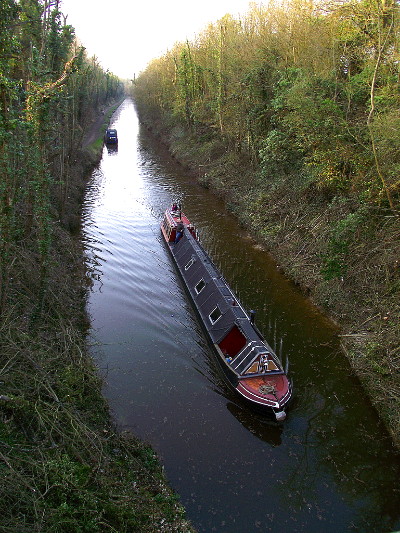 |
|
Tring Cutting, Grand
Union Canal. |
Work on the Tring Cutting commenced in September 1834. According to correspondence published in The Mechanics’ Magazine,
by the following year good progress had being made:
“The work through Tring Hill is proceeding very well, and, I may
say, rapidly. A ‘temporary bridge’ has been constructed across the
canal at Seabrook, to carry the earth over (the embankments being
finished as far as there). I understand it is not the intention of
the Company to put up the permanent bridge till all the earth shall
have been carried over. But the foundations for it have been put in
some time. The top is to be of iron. Mr. Townsend [sic.]
has lately been laying down a fresh set of rails (parallel
wrought-iron ones) in lieu of the common cast-iron, and a new set of
waggons have been put on the work. The temporary bridge over the
canal is something like a bridge when compared to that which was put
over the canal at Wolverton, and pulled down by the Canal Company.
[7]
(By-the-bye, I think a vote of thanks ought to have been passed by
the Railroad Company and forwarded to the Canal Company, thanking
them for their unbounded kindness in destroying a bridge which must
have broken by its own weight, and occasioned, probably, a great
loss of life. By what I can learn, they get on very badly in that
quarter). Mr. Townsend will complete his part, before the others are
well begun. He keeps his men very steadily at work.”
――――――――
“The excavation for the London and Birmingham Railway, through
Tring-hill, is proceeding rapidly. Mr Townsend
[sic.] the contractor has
upwards of 500 men employed besides a great number of horses. It
is expected they will intercept the ‘Bulbourne springs’ when they
get deeper. These springs at present come directly into the Grand
Junction Canal. There is only one fault to be found with the
work in this neighbourhood, and that is the steepness of the banks,
they being only, for the excavations, in the ratio of nine inches
horizontal to one foot perpendicular. In the event of a sharp frost,
this ground, which is a sort of chalk rag, will slake down like
lime, and will consequently be a great nuisance after the road is
finished. The banks of the Grand Junction Canal, in the deep
cuttings collateral with the railroad, are more than one to one, yet
the slips which have occurred after a sharp frost have been
prodigious.”
From letters published in The
Mechanics’ Magazine, Volume 23, 1835.
The magazine’s second correspondent was correct in his belief that
the excavation would intercept the Bulbourne Springs, as had been
James Barnes’ experience some 40 years earlier when excavating the
Grand Junction Canal cutting half a
mile to the west (See Chapter
VII., A Highway laid with Water). Robert Stephenson was later to report that:
|
“The Tring cutting on the L and B R/Way presents another
forcible example of the constant and rapid absorption of water by
the chalk. In the execution of that cutting a very large
quantity of water was encountered, notwithstanding the situation was
on the summit of the chalk ridge, forming the actual brim of the
basin, where it could not be supplied with any water but such as
fell upon the immediate neighbourhood, yet it yielded upwards of one
millions gallons per day, and continues to yield an extraordinary
quantity up to this hour, without any sensible diminution.”
Minutes of proceedings of the Institution of Civil
Engineers: Volume 90, Part 4. |
The
“large quantity of water” to which Stephenson refers is now
channelled from the railway cutting through a heading to enter the
canal summit.
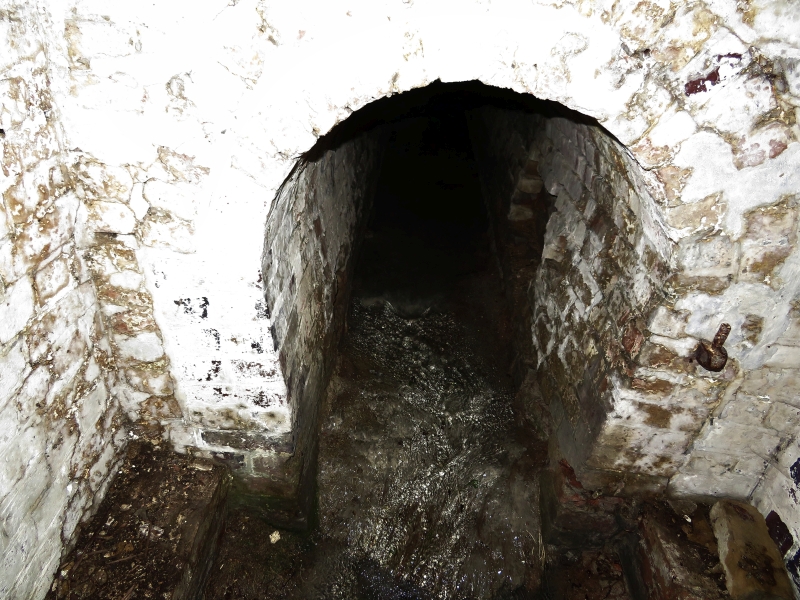
The culvert
that drains the Tring Railway Cutting into the summit of The Grand
Union Canal.
The flow of water shown here was after a period of
dry weather. The arch is about 4feet high.
During the drought of
1934, Edward Bell, the canal company’s surveyor, reported that he
was able to walk through the dried out heading, but not wishing to
retrace his steps he emerged into the railway cutting ― he mentions, as he climbed up the steep embankment, “feeling
very scared as an express train thundered along below”.

Tring Cutting after the track had
been widened during the 1870s to accommodate four tracks.
“The Tring Excavation is about two miles
and a half long. The strata through which it was cut are composed of
the lower or grey chalk formation, without flints. It averages forty
feet, and for about one quarter of a mile is fifty-seven feet in
depth. Out of this hill were taken one million and a half cubic
yards of earth, which had to be lifted to the surface a height of
forty feet and then deposited in ‘spoil banks’. It was executed by
means of a number of ‘horse runs’
so called by excavators from the men being drawn up planks nearly in
a perpendicular position by horses. A rope is attached to the front
of the barrow containing the soil, while the excavator takes firm
hold of the handles, and both barrow and man are drawn up the plank,
― the latter having his body nearly horizontal during the ascent. It
is a fearful practice; and should any accident occur, by the
breaking of the rope or restiveness of the horse, the workman is
precipitated to the bottom in an instant.”
The London and Birmingham Railway, Roscoe and
Lecount (1839).
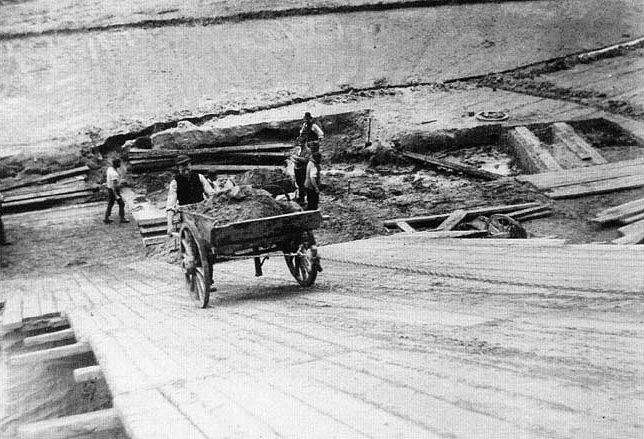
From a later era, a horse-run in use
on the Manchester Ship canal workings.
By February 1837, the Chairman was able to report to the General
Meeting that work on the Northchurch Tunnel was complete, and the
Board was optimistic that the line would be opened to Tring by the
Autumn. However, the heavy rain during the winter of 1836-37, together with the influx
of water from the Bulbourne Springs, brought work in the cutting to a
standstill:
“The
quantity of water yielded by the cutting, in addition to that which
has fallen in rain, together with the argillaceous character of the
chalk in the Tring contract, rendered it absolutely necessary to
stop proceedings on the embankment, and to confine them to the
side-cutting and spoil. It is but justice, however, to the
contractor to add that he persevered in carrying on the embankment,
until the engineer reported that it became positively impassable. Notwithstanding this temporary delay, the engineer is of opinion
that the completion of this contract will certainly not be much
protracted beyond October next.”
From the Report to the 7th
half-yearly General Meeting, February 1837.
In October 1837 ― apparently to the surprise of all concerned ―
Townshend relinquished his contract and the Company took over the
work:
“Another unpleasant affair for the Company
arose from the person who had the Tring contract becoming bankrupt ―
a matter least expected, perhaps, of any. He was a man of capital
and talent, and had established a reputation for years as an able
contractor. The works he had on his hands were of the most extensive
nature, and ought to have paid him well; when, to the surprise of
every one who knew him, he was suddenly declared to be in
difficulties through his contracts on the Grand Junction line, and
ultimately went into the [London]
Gazette, leaving his works at Tring, including the heavy cutting
through the chalk, to be finished as best it might.”
The History of the Railway
connecting London and Birmingham, Peter
Lecount (1839).
The reasons for
Townshend’s bankruptcy stemmed from difficulties over contracts he
had with the Grand Junction Railway Company coupled with a
substantial increase in wage rates, but within seven months he had
paid off his creditors and was able to return to
contracting during his final years.
The winter of 1837-38 was another of unusual severity, which delayed
work until the frost broke up. Stephenson was able to report to the
General Meeting held in February, that the Cutting was almost
complete and the next section of the line from the south would
shortly be opened:
“The
Tring Contract, which comprehended the most extensive excavation on
the line, is now nearly completed. The whole of the excavations and
embankments are ready for the further opening to Denbigh-hall,
except that about 4,000 yards of permanent road remain to be laid,
not in one length, but made up of several smaller portions. There
still remains work, which, as nearly as can be calculated, must
require three weeks to perform. The embankments throughout this
contract, consist almost entirely of chalk, which being already well
consolidated, and little liable to subsidence, the immediate use of
the permanent road may be reckoned upon as soon as completed.”
From the Report to the 9th
half-yearly General Meeting, February 1838.
The line from Tring to Denbigh Hall
was opened to the public on the 9th
April 1838.
|
CHAPTER 8
――――♦――――
|
FOOTNOTES. |
|
1. |
The clay is entirely free from water, but its absorbing
properties are such that when it is exposed to air it
swells out rapidly. |
|
2. |
A further viaduct to the west of the main line was built
to carry the former Watford and Rickmansworth Railway
(opened October 1862) over the valley of the River
Colne, between Bushey and Watford High Street stations. |
|
3. |
The wedge-shaped stone blocks used to line the facing
curves of each arch. |
|
4. |
At
its southern end, the Colne embankment was formed of
spoil excavated from the Oxhey cutting, at the northern
end with spoil from the Watford cutting. |
|
5. |
Although in Aldbury parish, Tring station lies at the
northern end of this section. |
|
6. |
“I remember,” said Robert
Stephenson, describing the opposition, “that we called
one day on Sir Astley Cooper, the eminent surgeon, in
the hope of overcoming his aversion to the railway.
He was one of our most inveterate and influential
opponents. His country house at Berkhamsted
[Hemel Hempstead] was
situated near the intended line, which passed through
part of his property. We found a courtly, fine-looking
old gentleman, of very stately manners, who received us
kindly and heard all we had to say in favour of the
project. But he was quite inflexible in his opposition
to it. No deviation or improvement that we could suggest
had any effect in conciliating him. He was opposed to
railways generally, and to this in particular. ‘Your
scheme,’ said he, ‘is preposterous in the extreme. It is
of so extravagant a character, as to be positively
absurd. Then look at the recklessness of your
proceedings! You are proposing to cut up our estates in
all directions for the purpose of making an unnecessary
road. Do you think for one moment of the destruction of
property involved by it? Why, gentlemen, if this sort of
thing be permitted to go on, you will in a very few
years destroy the noblesse!’ We left the honourable
baronet without having produced the slightest effect
upon him, excepting perhaps, it might be, increased
exasperation against our scheme. I could not help
observing to my companions as we left the house, ‘Well,
it is really provoking to find one who has been made a
“Sir” for cutting that wen out of George the Fourth’s
neck, charging us with contemplating the destruction of
the noblesse, because we propose to confer upon him the
benefits of a railroad.’”
Lives of the
Engineers ― George Stephenson and Robert Stephenson,
Samuel Smiles (1862). |
|
7. |
January 19th 1835: A company
[the London and Birmingham Railway Company]
were empowered by an act of Parliament to do all works
necessary and convenient for constructing a railway, and
among others to cross canals and make embankments in the
line; and in particular to cross a canal of which the
defendants [the Grand Junction Canal Company]
were the proprietors, and to make an embankment over a
valley near the same place.
Subsequent clauses in the act restricted the company
from doing any thing which should obstruct the
navigation of the canal, or any part thereof; and
specified the height and dimensions of any bridge to be
made and maintained for carrying the railway over the
canal.
The company, for the purpose of transporting earth from
the higher lands on the south to the lower land on the
north side of the canal for constructing an embankment,
erected a temporary bridge over the canal, supported
partly on piles driven into the bed of the canal.
The defendants pulled down such bridge and thereby
destroyed the passage of communication for the carriage
of the earth.
Held, by the Master of the Rolls, on a motion for an
injunction to restrain the defendants destroying any
such bridge, or preventing such communication, that the
clause empowering the railway company to cross canals in
the progress of their works was not restricted by the
subsequent clauses which applied to permanent bridges;
and his Honor therefore grained the defendants from
obstructing the making or use of such passage of
communication.
Cases Relating to
Railways and Canals: 1835-1840. |
――――♦――――
|
.htm_cmp_poetic110_bnr.gif)